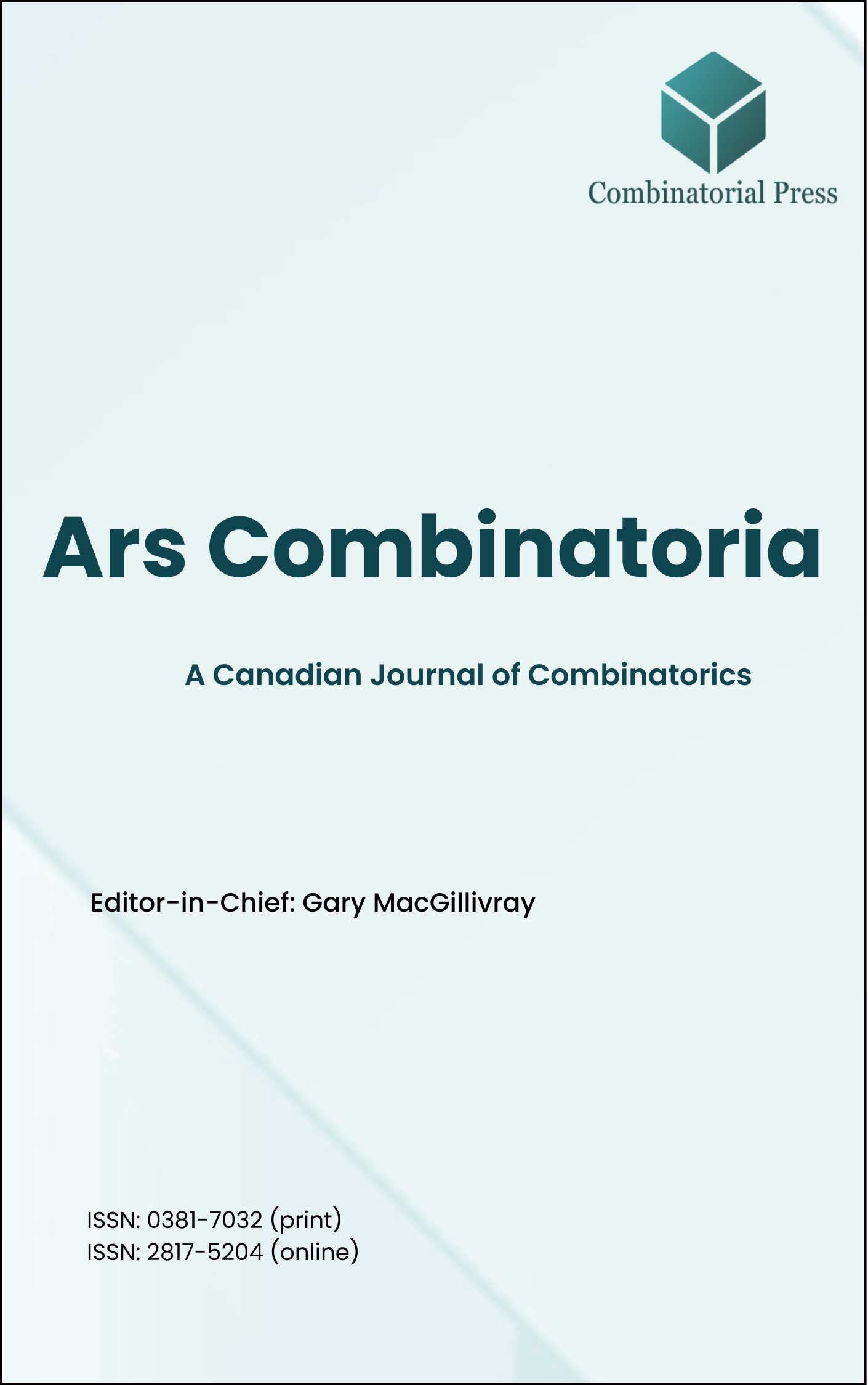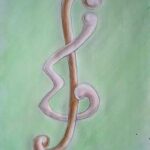
Ars Combinatoria
ISSN 0381-7032 (print), 2817-5204 (online)
Ars Combinatoria is the oldest Canadian Journal of Combinatorics, established in 1976. The journal is dedicated to advancing the field of combinatorial mathematics through the publication of high-quality research papers. From 2024 onward, it publishes four volumes per year in March, June, September and December. Ars Combinatoria has gained recognition and visibility in the academic community and is indexed in renowned databases such as MathSciNet, Zentralblatt, and Scopus. The Scope of the journal includes Graph theory, Design theory, Extremal combinatorics, Enumeration, Algebraic combinatorics, Combinatorial optimization, Ramsey theory, Automorphism groups, Coding theory, Finite geometries, Chemical graph theory but not limited.
Information Menu
- Research article
- Full Text
- Ars Combinatoria
- Volume 048
- Pages: 225-232
- Published: 30/04/1998
In this paper, we consider total clique covers and uniform intersection numbers on multifamilies. We determine the uniform intersection numbers of graphs in terms of total clique covers. From this result and some properties of intersection graphs on multifamilies, we determine the uniform intersection numbers of some families of graphs. We also deal with the \(NP\)-completeness of uniform intersection numbers.
- Research article
- Full Text
- Ars Combinatoria
- Volume 048
- Pages: 219-223
- Published: 30/04/1998
An oriented triple system of order \(v\), denoted OTS\((v)\), is said to be \(d\)-cyclic if it admits an automorphism consisting of a single cycle of length \(d\) and \(v-d\) fixed points, \(d\geq 2\). In this paper, we give necessary and sufficient conditions for the existence of \(d\)-cyclic OTS\((v)\). We solve the analogous problem for directed triple systems.
- Research article
- Full Text
- Ars Combinatoria
- Volume 048
- Pages: 213-218
- Published: 30/04/1998
Let \(A_m(n, k)\) denote the number of permutations of \(\{1, \ldots, n\}\) with exactly \(k\) rises of size at least \(m\). We show that, for each positive integer \(m\), the \(A_m(n, k)\) are asymptotically normal.
- Research article
- Full Text
- Ars Combinatoria
- Volume 048
- Pages: 195-212
- Published: 30/04/1998
Let \(G\) be a graph of order \(n\) and \( X\) a given vertex subset of \(G\). Define the parameters:
\(\alpha(V) = \max\{|S| \mid S\}\) is an independent set of vertices of the subgraph \(G(X)\) in \(G\) induced by \(X\)
and
\(\sigma_k(X) = \min\{|\Sigma_{i=1}^{k}d(x_i)| \mid \{x_1,x_2,\ldots,x_k\} \}\) is an independent vertex set in \( G[X]\)
A cycle \(C\) of \(G\) is called \(X\)-longest if no cycle of \(G\) contains more vertices of \(X\) than \(C\). A cycle \(C’\) of \(G\) is called \(X\)-dominating if all neighbors of each vertex of \(X\setminus V(C)\) are on \(C\). In particular, \(G\) is \(X\)-eyclable if \(G\) has an \(X\)-cycle, i.e., a cycle containing all vertices of \(X\). Our main result is as follows:
If \(G\) is \(1\)-tough and \(\sigma_3(X) \geq n\), then \(G\) has an \(X\)-longest cycle \(C\) such that \(C\) is an \(X\)-dominating cycle and \(|V(C) \cap X| \geq \min\{|X|. |X| + \frac{1}{3}\sigma_3(X) – \sigma(X)\}\), which extends the well-known results of D. Bauer et al. [2] in terms of \(X\)-cyclability. Finally, if \(G\) is \(2\)-tough and \(\sigma_3(X) \geq n\), then \(G\) is \(X\)-cyelable.
- Research article
- Full Text
- Ars Combinatoria
- Volume 048
- Pages: 191-194
- Published: 30/04/1998
In 1992, Mahmoodian and Soltankhah conjectured that, for all \(0 \leq i \leq t\), a \((v, k, t)\) trade of volume \(2^{t+1} – 2^{t-i}\) exists. In this paper we prove this conjecture and, as a corollary, show that if \(s \geq (2t – 1)2^t\) then there exists a \((v, k, t)\) trade of volume \(s\).
- Research article
- Full Text
- Ars Combinatoria
- Volume 048
- Pages: 185-190
- Published: 30/04/1998
We prove two new characterization theorems for finite Moufang polygons, one purely combinatorial, another group-theoretical. Both follow from a result of Andries Brouwer on the connectedness of the geometry opposite a flag in a finite generalized polygon.
- Research article
- Full Text
- Ars Combinatoria
- Volume 048
- Pages: 173-184
- Published: 30/04/1998
Cyclonomial coefficients are defined as a generalization of binomial coefficients. It is proved that each natural number can be expressed, in a unique way, as the sum of cyclonomial coefficients, satisfying certain conditions. This cyclonomial number system generalizes the well-known binomial number system. It appears that this system is the appropriate number system to index the words of the lexicographically ordered code \(L^q(n, k)\). This code consists of all words of length \(n\) over an alphabet of \(q\) symbols, such that the sum of the digits is constant. It provides efficient algorithms for the conversion of such a codeword to its index, and vice versa.
- Research article
- Full Text
- Ars Combinatoria
- Volume 048
- Pages: 161-172
- Published: 30/04/1998
We investigate the connections between families of graphs closed under (induced) subgraphs and their forbidden (induced) subgraph characterizations. In particular, we discuss going from a forbidden subgraph characterization of a family \(\mathbb{P}\) to a forbidden induced subgraph characterization of the family of line graphs of members of \(\mathbb{P}\) in the most general case. The inverse problem is considered too.
- Research article
- Full Text
- Ars Combinatoria
- Volume 048
- Pages: 147-160
- Published: 30/04/1998
A family of double circulant quasi-cyclic codes is constructed from the incidence matrices of difference sets associated with hyperplanes in projective space. A subset of these codes leads to a class of doubly-even self-orthogonal codes, and two classes of self-dual codes.
- Research article
- Full Text
- Ars Combinatoria
- Volume 048
- Pages: 135-146
- Published: 30/04/1998
All nonisomorphic \(2\)-\((21, 6, 3)\) designs with automorphisms of order \(7\) or \(5\) were found, and the orders of their groups of automorphisms were determined. There are \(33\) nonisomorphic \(2\)-\((21, 6, 3)\) designs with automorphisms of order \(7\) and \(203\) with automorphisms of order \(5\).





